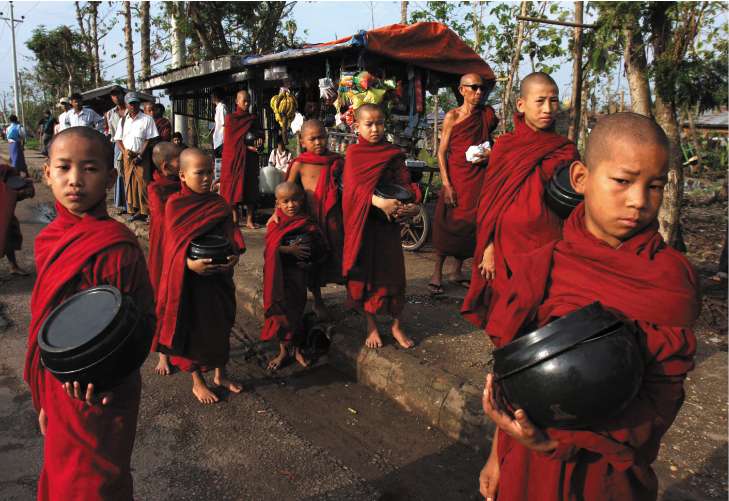Burma raises cyclone death toll to 78,000 but true figure much higher

Your support helps us to tell the story
From reproductive rights to climate change to Big Tech, The Independent is on the ground when the story is developing. Whether it's investigating the financials of Elon Musk's pro-Trump PAC or producing our latest documentary, 'The A Word', which shines a light on the American women fighting for reproductive rights, we know how important it is to parse out the facts from the messaging.
At such a critical moment in US history, we need reporters on the ground. Your donation allows us to keep sending journalists to speak to both sides of the story.
The Independent is trusted by Americans across the entire political spectrum. And unlike many other quality news outlets, we choose not to lock Americans out of our reporting and analysis with paywalls. We believe quality journalism should be available to everyone, paid for by those who can afford it.
Your support makes all the difference.The official total for the dead in Burma's cyclone disaster jumped to 78,000 yesterday, up from 43,000. The new figure was announced by Burmese state television, which said the number of missing had risen from 28,000 to 56,000.
Nobody knows what relation these figures may bear to reality because access to the stricken zone is tightly controlled by the military junta, though both the Red Cross and the United Nations believe the true figure is much higher even than the new official claims.
The survivors, up to 2.5 million of them, face an increasingly grim struggle for survival. A Reuters reporter who drove from Rangoon to Kuanyangon, about 60 miles south of the former capital, described the dispossessed lining the road, praying for aid.
"Without clothes or shoes, the thousands of men, women and children made destitute by the cyclone could only stand in the mud and rain of the latest tropical downpour, their hands clasped together in supplication at the occasional passing aid vehicle," the reporter wrote. "Any car that did stop was mobbed by children, their grimy hands reaching through a window in search of bits of bread or a T-shirt."
A Burmese volunteer who had travelled to the town commented: "The situation has worsened in just two days. There weren't this many desperate people when we were last here."
The petitioning of the desperate along the region's roads gave the lie to the regime's claim that the crisis is fully under control. The regime appropriates any aid and allows no checks on what becomes of it subsequently. Burma has one of the world's worst records for corruption, according to Transparency International.
As the Burmese authorities continued to guard the disaster area like a prison camp, the Red Cross warned that what the most desperate need now is for clean drinking water, if survivors are not to fall victim to dysentery and other diseases. "If clean water isn't available, it's going to be the biggest killer in the post-disaster environment," Thomas Gurtner, the head of operations for the Red Cross, said in Geneva. "Food is urgent, but you die in three days from acute diarrhoea. You die of starvation in a period of weeks."
Mr Gurtner doubted whether the 27,000 volunteers of the Myanmar Red Cross Society were up to the gigantic task of providing enough clean water. "It requires a major operation which we have neither the material, the logistical nor the staff capacity to do," he admitted. "If the Myanmar Red Cross remains the only agent that can move out, it is going to be a problem. It is one of the only agencies that has been able to distribute extensively."
The military regime continued to make tiny concessions. Foreign diplomats said the regime had agreed to give them a tour of the Irrawaddy delta. They will be the first foreigners permitted to inspect the scene.
The United Nations chief humanitarian affairs officer, John Holmes, flies to Burma tomorrow for talks which he hopes will persuade the generals to open the door to foreign aid. The brave talk in the UN and the EU of delivering aid even if the regime forbade it has fallen silent.
The regime's refusal to share information means that the outside world remains in the dark about the true scale of the disaster and the nature of the survivors' needs. Yesterday, the United Nations admitted it did not have a clue about the size of the emergency.
At a press conference called by several UN agencies in Bangkok, the most basic data was missing, from the number of children orphaned to the extent of disease to the number of refugee camps. They were also unable to say whether survivors were concentrated in camps, on the move, or still living in their destroyed villages.
Even information about deaths and survivors is hazy. The Red Cross fears the total may reach 128,000, the UN estimates that more than 200,000 are dead or missing. An unknown number may have been dragged out to sea by the retreating wave, meaning the true total will never be known.
BBC admits image error
The BBC has admitted that a graphic image it had claimed was of dozens of people killed by the Burmese cyclone had in fact been taken after the Boxing Day tsunami in Sumatra in 2004.
Peter Horrocks, the head of the newly created BBC multimedia newsroom, said the corporation was reviewing the processes by which it receives pictures.
The picture was used during a BBC News report by the correspondent Natalia Antelava on Thursday night, purportedly showing dozens of bodies that Antelava had seen in the Irrawaddy Delta. The picture also featured in an introduction to a report by Huw Edwards. The account was broadcast after Antelava left Burma in order to protect the correspondent, the BBC said.
James Macintyre
Join our commenting forum
Join thought-provoking conversations, follow other Independent readers and see their replies
Comments